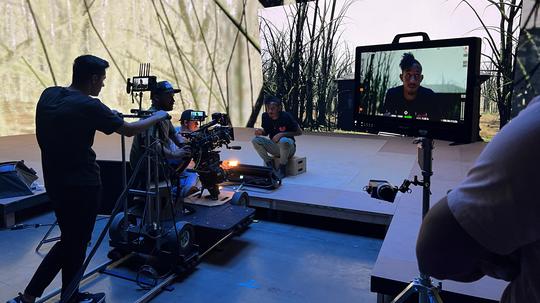
Arizona cinematography may be best known for its desert backdrops and Old West showdowns. Lately, however, the state is drawing the eyes of filmmakers for another reason – high-tech film studios.
XR technology, also known as extended reality, has emerged as a virtual alternative to green screens, with walls made up of LED panels that display immersive environments in real-time. In “virtual production,” filmmakers use XR to capture entire scenes in-camera, without the need for set extensions.
The technique catapulted to the forefront of film technology with the 2019 release of Disney’s The Mandalorian, which harnessed virtual sets and a 360-degree video wall to create the series’ far-flung environments.
Arizona is home to sophisticated tech-advanced production companies such Phoenix-based 3500 Kelvin, Murray Scott Production Services (MSPS), Bit Fire, and Sneaky Big.
3500 Kelvin is a creative agency composed of research and development focused artists, creators, and technical craftspeople. The company provides full in-house cinema quality production services, including virtual production.
“What’s so great about Arizona is that we’re not burdened with the same rules and regulations as other states, which allows us more creative flexibility in our research and development initiatives,” said Mac Jeffries, founder and virtual production manager of 3500 Kelvin. “For this reason, we’ve been able to push the boundaries in advanced virtual production, paving the way for a new process that will be adopted by the greater film community.”
With virtual production changing the nature of film, Arizona State University (ASU) plans to offer a course training students to use the advanced software underpinning XR. In addition, at Mesa City Center, ASU is finishing construction on a 118,000-square-foot facility to house innovative sound stages, editing suites, screening theaters, public exhibitions space, fabrication labs, and an immersive media studio.
The facility will be part of the new Sidney Poitier New American Film School.
In recent years, Arizona’s film attractiveness has drawn some of the biggest names in the industry.
In 2021, Warner Bros. Television Studios selected Tucson to shoot the pilot for Duster, a series to air on HBO Max.
According to Film Tucson, the filming for the pilot episode alone translates to the hiring of 488 local actors and 85 local crew along with nearly 9,800 hotel room bookings — injecting $10 million into the local economy.
“As you can see by these numbers, luring a major TV series to Arizona instantly brings a large quantity of jobs for local crew, a mammoth tally of hotel room nights, and an astonishing economic impact,” said Peter Catalanotte, Film Tucson director.
According to Matthew Earl Jones, director of Arizona film and digital media, a program of the Arizona Commerce Authority (ACA), Warner Bros.’ selection of Tucson has brought a cascade of new film inquiries.
“Once we demonstrated that we could handle a project of that size, a lot of people were willing to look at Arizona in a fundamentally different way,” said Earl Jones.
To capitalize on the growing momentum, the ACA has launched a new partnership with five community colleges around the state to bolster Arizona’s film workforce. The comprehensive training program aims to graduate 400 students a year, providing a high-skilled, ready-made workforce for new productions.
Other partnerships are maximizing Arizona’s unique geographic and cultural assets.
Last August, the Navajo Nation and ACA announced a commitment to promote Navajo Nation as a major international film and media destination. The partnership aims to build a foundation of generational opportunities in the film and media industry and more fully capitalize on Arizona’s unique film and media attractiveness.
The Navajo Nation collaboration mirrors a similar agreement signed in 2019 with the government of Sonora, Mexico, to draw more film and digital media production to the region.
“With some of the most diverse topography on the planet, a growing talent base, and pioneering new production capabilities, Arizona is well-positioned to be a major film production hub for years to come,” said Earl Jones.
To learn more about the Arizona Film Office, visit: azcommerce.com/film-media/